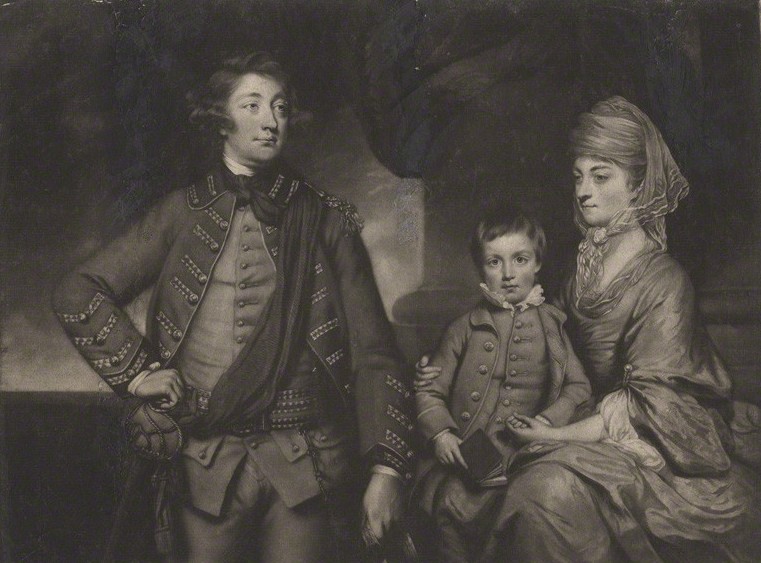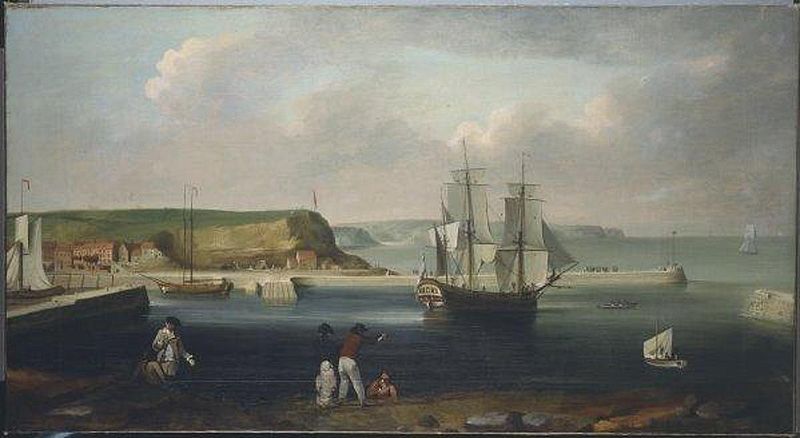
Henry Herbert, 10th Earl of Pembroke and 7th Earl of Montgomery,
Henry was
appointed
Lord Lieutenant of Wiltshire
3 April 1756.
Held that post until 22 March 1780.
On 27 Sept 1756 he became a Major
in the 1st Foot Guards.
He was made a Lord of the Bedchamber to
George, Prince of Wales (later George III) in Nov 1756.
In 1756-59 he re-built the family's town house,
Pembroke House, London.
He lived in the family's old London house,
12 St James's Square, London,
until Pembroke House was finished in 1759.
In 1759 he became
Lieutenant Colonel
in the new
15th Light Dragoons.
He
was despatched c. early 1760 with his regiment to Germany
to take part in the
Seven Years' War
(spanned 1756-63, Prussia was Britain's ally).
He served under
John Manners, Marquess of Granby
(as did
Dr. William Kerr).
He was present at the Battle of Warburg, central Germany, 31 July 1760.
Lord of the Bedchamber to
George III 1760-1763.
He became a Major-General 10 Mar 1761.
He commanded the Cavalry Brigade in Germany 1761-63.
He
wrote the British Army's manual on riding,
Military Equitation: or A Method of Breaking Horses, and Teaching Soldiers to Ride
(1761).
His methods were adopted throughout the British cavalry.
(His book had gone into
4th edn
by 1793.)
Henry returned to England Feb 1763 and was reconciled to his wife Mar 1763.
His wife
Elizabeth was admired by the King
George III
in the early 1760s.
This came back to embarrass her
when he suffered madness in later life.
The Marquess of Tavistock
was also
an admirer of Lady Pembroke, and he
"studied law for six months to see whether a divorce was possible for a wife 'on the notorious adultery of her husband'"
[Thomas, 2008].
In 1768 Henry wrote another book, Instructions for the Education of Cavalry.
Henry was again a Lord of the Bedchamber to
George III in 1770-1780.
He became a
Lieutenant-General 1770.
The King and Queen stayed with them at
Wilton for two nights in 1778.
See Royal visit to Wilton, 1778.
"Husbands are dreadfull and powerfull Animals" wrote the long-suffering Elizabeth
after taking her husband back.
But she was not completely helpless.
She prevented him from giving Reebkomp the surname "Herbert".
(Reebkomp had to make do with adopting the name "Montgomery" in
1781.)
She and Henry ended up in separate quarters at Wilton (him downstairs, her upstairs).
Henry advanced to the rank
of
General in 1782.
He was Lord Lieutenant of Wiltshire
again from 8 April 1782 to death 1794.
He was
Governor of Portsmouth 1782-1794.
See inventories of his property
at the Government House, Portsmouth, dates 1785 to 1792.
Elizabeth leaves Henry:
Elizabeth was Lady of the Bedchamber
to Queen Charlotte
in
1783-1818.
Eventually she left Henry in 1788.
She moved to Pembroke Lodge, Richmond Park, London.
This was a house granted to her by the King in 1787.
She moved there in 1788
and extended it.
The King's madness:
But then the King, who had been attracted to Elizabeth all his life,
suffered his first bout of insanity in 1788,
and she had to endure (at age 51) the embarrassment of his unwanted attentions.
See will of 10th Earl dated 26 May 1788.
He leaves Wilton House and Pembroke House to his son George.
At the start of the will he says he leaves £1000 to his wife
and then immediately says he leaves £100
to his ex-lover Kitty Hunter.
He then makes provision for his son by her, Augustus Montgomery.
He then makes provision for a list of children, who may be further natural children of his.
Henry dies, 1794:
The last codicil to his will was written 21 Sept 1793.
In a letter of 26 Dec 1793 it is reported that he has had what seems like a stroke
and is part paralysed.
He
died at Wilton, 26 Jan 1794, age 59 yrs.
He was
bur 3 Feb 1794 at
Wilton parish church.
His will proved 21 March 1794,
Prerogative Court of Canterbury.
Elizabeth continued to live at Pembroke Lodge in London,
leaving Wilton House to her son the 11th Earl.
Augustus Reebkomp died 1797.
Elizabeth suffered the unwanted attentions of the King sporadically until 1805 (her age 68).
She outlived her son the 11th Earl
who died 26 Oct 1827.
She outlived both her son and her husband's natural son.
Her will dated 17 Nov 1827.
Elizabeth dies, 1831:
She is listed as of Richmond Park at death.
She died at Pembroke Lodge, 30 Apr 1831, age 93 yrs.
Her will proved 26 May 1831,
Prerogative Court of Canterbury.


Listing of the Earls in
[Watson's Almanack, Dublin, 1761].
Shows the 10th Earl of Pembroke
with his London town house at
"Privy-Garden".
See full size.
See another copy.


Title page of the
4th edn (1793)
of the 10th Earl's book
Military Equitation.
The 1st edn was dated from
Pembroke House
15 Feb 1761.


Letter of 26 Dec 1793 from
Susanna, Marchioness of Stafford
to her son
Granville Leveson-Gower (later 1st Earl Granville).
This reports that the 10th Earl of Pembroke has had what seems like a stroke
and is part paralysed.
Lady Stafford hopes that he will now repent of his "great Sins" before his death.
From pp.72-73
of vol.1
of Lord Granville Leveson Gower: private correspondence,
pub 1916.



The concert with the bell-ringers,
and two later scenes with the Prince of Wales,
are actually shot in the Double Cube Room at Wilton
(with group portrait
visible).
Though it is not meant to be Wilton in the story.




10th Earl
in [Complete Peerage].


Reebkomp's baptism in Holland, 16 Dec 1762.
See full size.


Will of 10th Earl
sets up provision for a number of children.
Starting with this boy, apparently called George Bell,
who was born 5 Oct 1773 and baptised 28 Oct 1773.
There are more children listed below him, including one in Naples.
Can they all be the 10th Earl's natural children?
Please donate to support this site.
I have spent a great deal of time and money on this research.
Research involves travel and many expenses.
Some research "things to do"
are not done for years, because I do not have the money to do them.
Please Donate Here
to support the ongoing research and
to keep this website free.